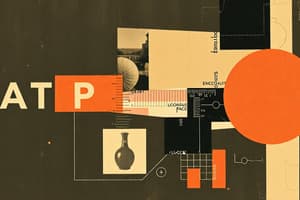Podcast
Questions and Answers
Which condition is characterized by the inability to produce sufficient insulin?
Which condition is characterized by the inability to produce sufficient insulin?
- Pre-diabetes
- Type I diabetes mellitus (correct)
- Type II diabetes mellitus
- Polydipsia
What does an increased HbA1c level indicate?
What does an increased HbA1c level indicate?
- Average blood glucose levels over weeks (correct)
- Current fasting glucose levels
- Immediate response to sugar intake
- Insulin resistance only
How does diabetes mellitus contribute to atherosclerosis?
How does diabetes mellitus contribute to atherosclerosis?
- Through excess glucose causing endothelial damage (correct)
- Through lower blood pressure
- By increasing insulin sensitivity
- By promoting the production of HDL cholesterol
What is a common feature of both Type I and Type II diabetes mellitus?
What is a common feature of both Type I and Type II diabetes mellitus?
Which of the following best describes 'pre-diabetes'?
Which of the following best describes 'pre-diabetes'?
What leads to an increase in the risk of heart attack and stroke in diabetic patients?
What leads to an increase in the risk of heart attack and stroke in diabetic patients?
What happens to glucose in individuals with Type II diabetes mellitus?
What happens to glucose in individuals with Type II diabetes mellitus?
What is one of the fates of energy released from breaking the phosphate bonds in ATP?
What is one of the fates of energy released from breaking the phosphate bonds in ATP?
Which of the following pathways are involved in the production of ATP?
Which of the following pathways are involved in the production of ATP?
What reaction describes the process by which phosphocreatine generates ATP?
What reaction describes the process by which phosphocreatine generates ATP?
What is the primary end product of glycolysis when glucose is used?
What is the primary end product of glycolysis when glucose is used?
Which source of anaerobic ATP production can sustain exercise for about 30-60 seconds?
Which source of anaerobic ATP production can sustain exercise for about 30-60 seconds?
Which source in the body contains the most energy?
Which source in the body contains the most energy?
What hormone is responsible for promoting the conversion of glucose to glycogen?
What hormone is responsible for promoting the conversion of glucose to glycogen?
What is a key characteristic of Diabetes Mellitus?
What is a key characteristic of Diabetes Mellitus?
Study Notes
Energy Production and ATP
- ATP (adenosine triphosphate) is the primary energy currency of the cell.
- Energy released from breaking phosphate bonds in ATP can be used to drive chemical reactions and generate heat.
- ATP can be produced through different pathways:
- Combustion of carbohydrates:
- Glycolysis: breakdown of glucose to pyruvate
- Citric acid cycle: further breakdown of pyruvate to carbon dioxide
- Combustion of fatty acids: Beta-oxidation
- Combustion of proteins: breakdown to amino acids, eventually contributing to energy production
- Combustion of carbohydrates:
Phosphocreatine
- Acts as an immediate energy source for ATP production.
- Reversible reaction: Phosphocreatine + ADP ↔ ATP + Creatine
- Moves rightward when ATP levels are depleted to maintain high ATP levels.
- Moves leftward when ATP demand is low to resynthesize phosphocreatine.
- Known as "creatine phosphate".
Glycolysis
- Breakdown of glucose to pyruvate, producing ATP.
- Yields:
- 2 ATP molecules if glucose is used.
- 3 ATP molecules if glycogen is used (better source of energy).
Anaerobic ATP Production
- Sources:
- Existing ATP in the cell (~1 second)
- Phosphocreatine (5-10 seconds)
- Glycolysis (~30-60 seconds)
Body's Energy Sources
- Fat mass is the most abundant energy source.
- Glycogen is the storage form of glucose, found in the liver, skeletal muscle, and kidneys.
- Glucose is found in the bloodstream.
- Protein is abundant but not typically used for ATP production.
Blood Glucose Regulation
- Key hormones:
- Insulin:
- Takes glucose from the blood and stores it as glycogen in muscle, adipose tissue, and liver.
- Lowers blood glucose levels and promotes glycogen formation.
- Turns off gluconeogenesis.
- Glucagon and epinephrine:
- Promote glucose production in the liver.
- Insulin:
- Processes:
- Glycogenesis: production of glycogen from glucose.
- Glycogenolysis: breakdown of glycogen.
- Gluconeogenesis: formation of new glucose from amino acids.
Diabetes Mellitus
- Characterized by excess blood glucose:
- Glucose accumulates in the urine, making it sweet.
- Causes polyuria (excess urine) and polydipsia (excess thirst) due to osmotic activity of glucose.
- Type I diabetes:
- Pancreatic dysfunction, inability to produce sufficient insulin.
- Often immune-mediated.
- Type II diabetes:
- Cells are less sensitive to insulin despite sufficient production.
- Glucose cannot enter muscle and adipose tissue, leading to high blood glucose levels.
Diabetes and Atherosclerosis
- Excess glucose can damage endothelial cells.
- This damage promotes the formation of atherosclerotic plaques.
- Consequences:
- Impaired blood flow to organs, leading to dysfunction.
- Increased risk of heart attack and stroke.
HbA1c Test
- Measures the percentage of hemoglobin that has been glycosylated (exposed to glucose).
- Reflects average blood glucose levels over several weeks.
- Provides a more informative measure than a single fasting blood glucose value.
- Can detect impaired glucose tolerance even when fasting blood glucose is normal.
Pre-Diabetes
- Fasting blood glucose is above normal (>100 mg/dL) but below the diabetes threshold.
Studying That Suits You
Use AI to generate personalized quizzes and flashcards to suit your learning preferences.
Description
This quiz explores the essential processes of energy production in cells, focusing on ATP, its synthesis, and the various metabolic pathways involved, such as glycolysis and the citric acid cycle. Understand the role of phosphocreatine in maintaining ATP levels during energy demands. Perfect for students of biochemistry and cellular metabolism.




